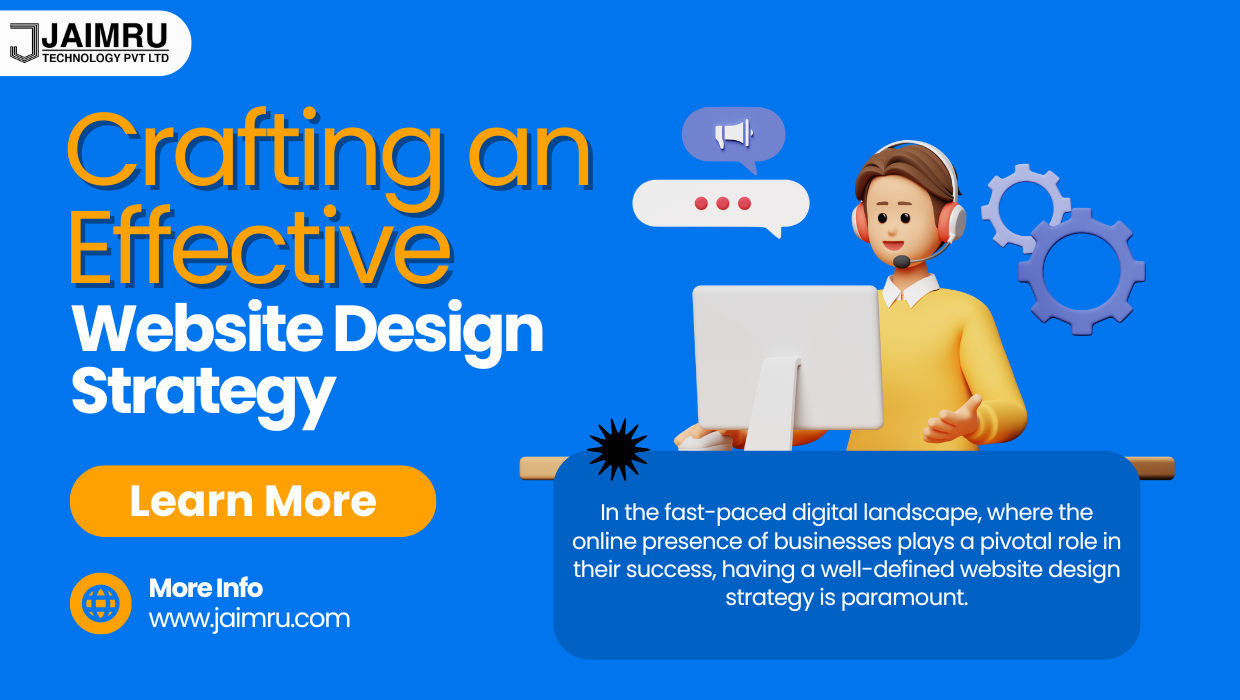
Posted On : 24-06-2024 10:52:00
In the fast-paced digital landscape, where the online presence of businesses plays a pivotal role in their success, having a well-defined website design strategy is paramount. A strategic approach to website design ensures that every aspect of the website—from its layout and navigation to its aesthetics and functionality—is aligned with the goals of the business and the needs of its target audience.
While there is no one-size-fits-all solution, several guiding principles and best practices can inform an effective website design strategy. In this comprehensive guide, we will explore these strategies and offer insights into crafting a website design strategy that drives results.
The foundation of any successful Website Design Strategy lies in a deep understanding of the target audience. By gaining insights into the demographics, preferences, behaviors, and pain points of your audience, you can tailor your website to meet their needs effectively.
Conducting market research, analyzing user data, and creating user personas can help you develop a clear picture of your target audience and inform key decisions regarding design elements, content strategy, and user experience.
Before diving into the design process, it's essential to define clear objectives for your website. Whether your goal is to increase brand awareness, generate leads, drive sales, or provide valuable resources to your audience, having clearly defined objectives will guide the design process and ensure that every element of your website serves a purpose.
These objectives should be specific, measurable, achievable, relevant, and time-bound (SMART), allowing you to track progress and evaluate the success of your website design strategy effectively.
User experience (UX) is a critical component of effective website design, as it directly impacts how visitors interact with your site and perceive your brand. A user-centric approach to design involves prioritizing the needs and preferences of your audience, ensuring that they can navigate your website seamlessly and find the information or products they seek with ease.
Key principles of good UX design include intuitive navigation, fast loading times, mobile responsiveness, clear calls to action, and user-friendly forms. By prioritizing UX, you can enhance engagement, reduce bounce rates, and increase conversions.
With the proliferation of mobile devices, ensuring that your website is optimized for mobile users is no longer optional—it's essential. Responsive design is a design approach that ensures your website adapts seamlessly to different screen sizes and devices, providing a consistent and user-friendly experience across desktops, laptops, smartphones, and tablets.
By embracing responsive design principles, you can reach a broader audience, improve search engine rankings (as Google prioritizes mobile-friendly sites), and future-proof your website against evolving technology trends.
In today's fast-paced digital environment, users expect websites to load quickly and perform smoothly. Slow-loading pages not only frustrate visitors but also negatively impact search engine rankings and conversion rates.
Optimizing your website for performance and speed involves several strategies, including minimizing HTTP requests, leveraging browser caching, compressing images, and optimizing code. By prioritizing performance optimization, you can create a seamless browsing experience for your audience, improve user satisfaction, and maximize engagement.
Search engine optimization (SEO) is crucial for ensuring that your website ranks well in search engine results pages (SERPs) and drives organic traffic to your site. While SEO encompasses various strategies and tactics, there are several key principles that should inform your website design strategy.
These include creating high-quality, relevant content; optimizing on-page elements such as title tags, meta descriptions, and headings; improving site structure and navigation for better crawl ability; and building high-quality backlinks from authoritative sources. By incorporating SEO best practices into your website design strategy, you can increase visibility, attract qualified traffic, and grow your online presence.
Visual hierarchy plays a crucial role in guiding users' attention and conveying the most important information on your website. By strategically organizing content, using contrasting colors and fonts, and incorporating visual cues such as arrows and icons, you can create a clear and intuitive hierarchy that helps users navigate your site more effectively. Additionally, consistent branding across your website—including colors, fonts, imagery, and tone of voice—helps reinforce your brand identity and foster trust with your audience. By leveraging visual hierarchy and branding, you can create a memorable and cohesive user experience that resonates with your target audience.
Effective website design is an iterative process that requires continuous testing and refinement to achieve optimal results. A/B testing, usability testing, heat maps, and user feedback are valuable tools for evaluating the performance of your website and identifying areas for improvement.
By analyzing user behavior and iterating based on insights gathered from testing, you can refine your website design strategy, optimize conversions, and enhance user satisfaction over time.
Crafting an Effective Website Design strategy requires careful planning, a deep understanding of your audience, and a commitment to delivering an exceptional user experience. By prioritizing user-centric design, embracing responsive design principles, optimizing for performance and speed, implementing SEO best practices, leveraging visual hierarchy and branding, and testing and iterating on your design, you can create a website that not only engages and delights your audience but also drives meaningful results for your business.
By following the strategies outlined in this guide, you can develop a website design strategy that sets your business up for success in the competitive digital landscape.
Copyright 20-2025 Jaimru Technology Private Limited | All Rights Reserved.